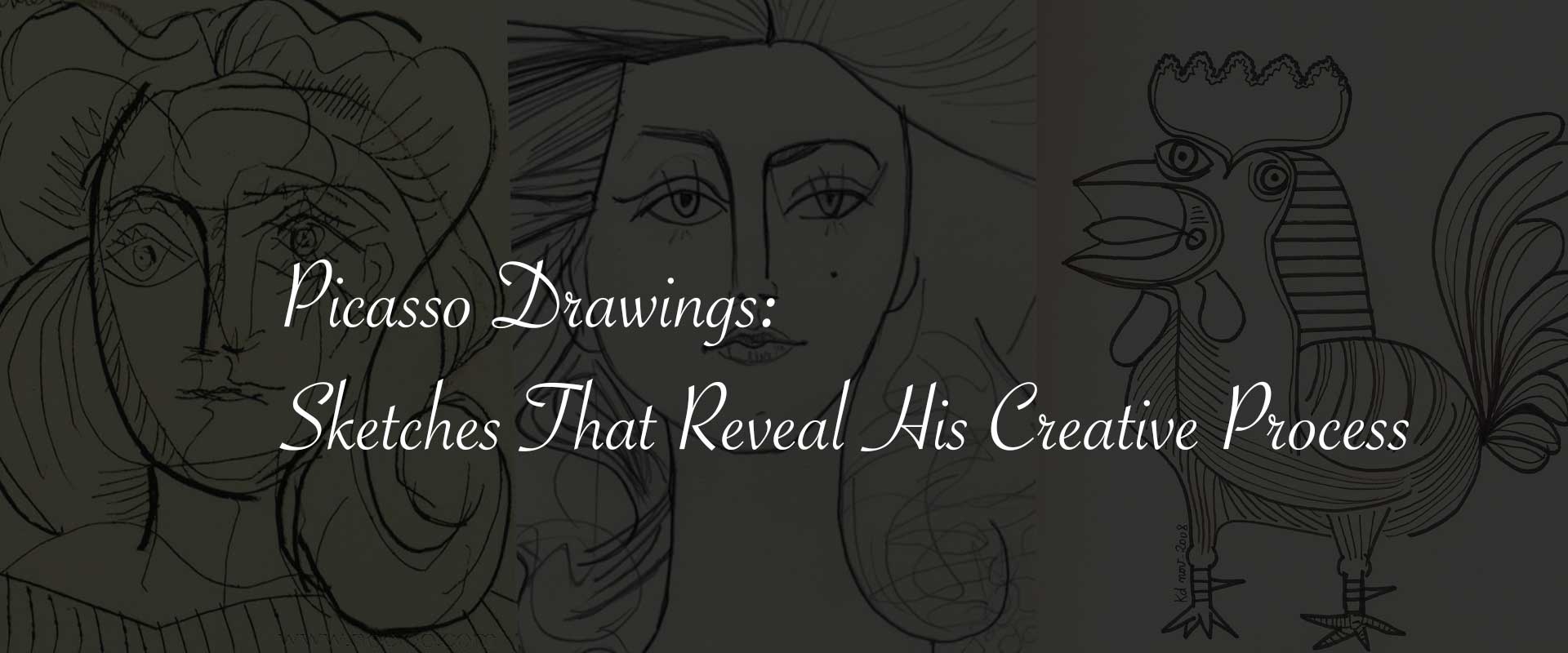While Pablo Picasso is celebrated for monumental works like Guernica and Les Demoiselles d’Avignon, his drawings and sketches often provide the most intimate glimpse into his mind. These works on paper reveal how he conceived ideas, experimented with form, and refined his vision before applying brush to canvas.
The world of Picasso drawings spans his entire career—from childhood sketches that foreshadowed prodigious talent to late, whimsical studies. They remind us that the foundation of Picasso’s genius was not just color or scale, but the humble line.
Early Drawings – Signs of a Prodigy
From the age of seven, Picasso was producing remarkably sophisticated drawings. His father, an art teacher, trained him in classical methods.
- Academic studies of hands and feet show technical mastery far beyond his years.
- Bullfighting sketches reflect Spanish traditions that remained a lifelong theme.
- Early portraits demonstrate his precocious ability to capture likeness and mood.
These works foreshadowed the innovation to come while proving that Picasso’s radical later styles were built on a foundation of classical skill.
Sketches Behind Major Works
Picasso rarely arrived at a masterpiece in one step. His preparatory drawings reveal how he experimented with composition, symbolism, and perspective.
For Les Demoiselles d’Avignon (1907)
Hundreds of sketches show how the figures evolved from realistic nudes into fragmented, mask-like forms. These studies mark the birth of Cubism, as Picasso stripped away naturalism in pursuit of structure and abstraction.
For Guernica (1937)
Dozens of preparatory drawings survive, documenting how Picasso built the chaotic mural piece by piece. Early sketches explore the bull, the screaming horse, and the grieving mother separately before assembling them into the monumental whole.
As discussed in Pablo Picasso Guernica Painting – A Visual Analysis, these drawings show his iterative process, revealing how symbols were tested and refined.
Why Picasso’s Drawings Matter
- Provide insight into his step-by-step creative process
- Reveal his technical skill underlying abstraction
- Showcase experimentation before committing to canvas
- Highlight themes—bulls, women, musicians—that persisted throughout his career
- Offer intimate glimpses into his daily artistic practice
Drawings as Independent Works
Not all Picasso drawings were preparatory. Many stand as artworks in their own right.
- Portrait sketches of friends and lovers often capture raw intimacy.
- Animal studies, especially bulls and doves, became symbols central to his career.
- Line drawings of faces, often completed in a single stroke, demonstrate his economy of means.
- Illustrations and book designs, particularly his work for poetry, combined text and image seamlessly.
These drawings highlight Picasso’s belief that a single line could express as much as an elaborate painting.
Comparison: Picasso’s Drawings vs Paintings
| Medium | Strengths | Purpose | Example |
|---|---|---|---|
| Drawings | Precision, immediacy, experimentation | Sketch ideas, refine forms, or stand alone | Guernica studies, bull sketches |
| Paintings | Color, scale, permanence | Completed artworks for public viewing | Les Demoiselles d’Avignon, Guernica |
This table shows how drawings often formed the bridge between thought and finished masterpiece.
Drawings of His Muses
Picasso’s muses—Fernande Olivier, Dora Maar, Marie-Thérèse Walter, and Françoise Gilot—appear frequently in his sketches. Quick studies often capture fleeting expressions, while more detailed drawings explore identity, emotion, and form.
As explored in Picasso Portraits That Redefined the Art of Representation, these works redefined how faces could be represented, often fractured into multiple perspectives.
Characteristics of Picasso Drawings
- Use of continuous line to create entire forms without lifting the pencil
- Minimalism that conveyed maximum emotion
- Frequent revisiting of themes such as bulls, doves, harlequins, and guitars
- Drawings often paired with poetry or text, showing his interdisciplinary creativity
- Ability to shift between classical realism and radical abstraction within the same sketchbook
Global Legacy of Picasso’s Drawings
Today, Picasso’s drawings are prized by museums and collectors alike. They are preserved in collections such as:
- The Museu Picasso in Barcelona, which houses his early sketches and student works
- The Musée Picasso in Paris, with thousands of preparatory studies
- The Museo Reina Sofía in Madrid, where Guernica drawings contextualize the masterpiece
For admirers, reproductions available through Pablo Picasso Wall Art Prints allow his intimate sketches to be enjoyed in personal spaces.
Conclusion
Picasso drawings reveal the foundation of his genius. They capture the raw energy of thought, the shaping of symbols, and the technical mastery beneath his innovations. Whether preparatory studies for Guernica or simple line sketches of a dove, his drawings strip art to its essentials—proving that a single stroke can hold a universe of meaning.
Through them, we not only witness Picasso’s creative process but also understand why he remains a figure of endless fascination: always experimenting, always innovating, and always redefining what art can be.
FAQs on Picasso Drawings
Why are Picasso’s drawings important?
They reveal his creative process, experimentation, and technical skill underlying his paintings.
Did Picasso make many sketches?
Yes, thousands survive, ranging from childhood studies to late minimalistic line drawings.
Are Picasso’s drawings considered artworks in their own right?
Absolutely. Many drawings were intended as complete pieces, not just preparatory sketches.
What subjects did Picasso draw most often?
He frequently drew bulls, doves, harlequins, portraits of muses, and preparatory studies for major works.
Where can I see Picasso’s drawings today?
They are housed in major museums such as the Museu Picasso in Barcelona, Musée Picasso in Paris, and Museo Reina Sofía in Madrid.





